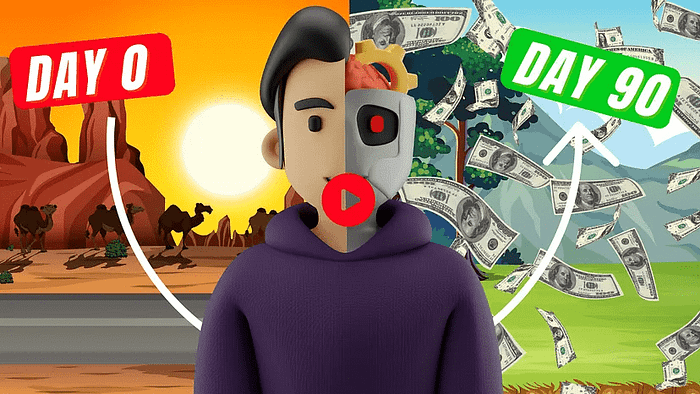How Do Websites Make Money? A Deep Dive into Online Revenue Models
Curious minds often wonder: how do websites make money in the vast digital landscape?
This question sparks intrigue among internet users and aspiring entrepreneurs alike.
The web has revolutionized commerce, creating unique opportunities for profit.
Understanding these revenue models is crucial in today’s interconnected world.
From small blogs to tech giants, websites employ various strategies to generate income.
This article will explore the diverse ways websites turn clicks into cash.
We’ll uncover the mechanics behind online profitability and digital success.
Prepare to dive deep into the fascinating world of web-based money-making methods.
We strongly recommend that you check out our guide on how to take advantage of AI in today’s passive income economy.
Table of Contents
The Foundation of Website Monetization
Traffic: The Lifeblood of Online Revenue
At the core of website monetization lies one crucial element: traffic.
Without visitors, even the most brilliant money-making strategies fall flat.
High-quality content and effective marketing drive users to a site.
These visitors become the foundation upon which revenue models are built.
Understanding your audience is key to choosing the right monetization methods.
Different types of traffic respond better to certain revenue strategies.
Niche audiences may prefer specialized products or subscription services.
Broader audiences might be more receptive to advertising-based models.
User Engagement: Turning Visitors into Value
Once traffic is established, engagement becomes the next crucial factor.
Websites must captivate visitors, encouraging them to stay and interact.
Engaged users are more likely to click ads, make purchases, or subscribe.
Creating a user-friendly experience is essential for maintaining engagement.
Interactive features, compelling content, and responsive design all play a role.
The longer users stay, the more opportunities arise to generate revenue.
Engagement metrics help website owners refine their monetization strategies.
By analyzing user behavior, sites can optimize their income-generating potential.
Advertising: The Backbone of Website Revenue
Display Advertising: Visual Marketing for Profit
One of the most common ways websites make money is through display advertising.
These visual ads appear as banners, sidebars, or in-content placements.
Advertisers pay websites based on impressions, clicks, or specific actions.
The effectiveness of display ads depends on targeting and relevance.
Websites use sophisticated algorithms to match ads with user interests.
This personalization increases the likelihood of user engagement with ads.
However, overuse of display ads can lead to a poor user experience.
Striking a balance between ad revenue and user satisfaction is crucial.
Native Advertising: Seamless Integration for Better Results
Native advertising has gained popularity as a less intrusive monetization method.
These ads blend seamlessly with the website’s content and design.
They often take the form of sponsored articles or recommended content.
Native ads can be more effective than traditional display advertising.
Users are more likely to engage with content that doesn’t feel like an ad.
This format allows for more creative and informative advertising approaches.
Websites benefit from higher engagement rates and potentially higher revenue.
Transparency is key, as native ads must be clearly labeled to maintain trust.
Video Advertising: Capturing Attention and Dollars
Video advertising has exploded in popularity with the rise of multimedia content.
Websites incorporate video ads before, during, or after video content.
These ads can command higher rates due to their engaging nature.
Pre-roll ads, which play before the main content, are particularly common.
Mid-roll and post-roll ads offer additional opportunities for monetization.
Interactive video ads can boost engagement and conversion rates.
Websites must balance ad frequency with user experience to avoid frustration.
As video consumption grows, this ad format continues to be a lucrative option.
Affiliate Marketing: Earning Through Recommendations
How Affiliate Programs Work
Affiliate marketing is another popular way websites make money online.
This model involves promoting products or services and earning commissions.
Websites include special links to products on e-commerce platforms.
When users make purchases through these links, the site earns a percentage.
Successful affiliate marketing requires trust and relevance to the audience.
Websites must choose products that align with their content and values.
Transparency about affiliate relationships is important for maintaining credibility.
This model can be particularly effective for niche websites and influencers.
Choosing the Right Affiliate Programs
Selecting appropriate affiliate programs is crucial for maximizing revenue.
Websites should consider their audience’s interests and needs.
High-commission programs might seem attractive but may not convert well.
It’s often better to focus on products that genuinely benefit the audience.
Some websites create content specifically to support affiliate marketing.
Product reviews, comparisons, and how-to guides can be effective formats.
Diversifying affiliate partnerships can help stabilize income streams.
Regularly analyzing performance helps optimize affiliate marketing strategies.
E-commerce: Direct Sales as a Revenue Model
Setting Up an Online Store
Many websites make money by selling products or services directly to consumers.
E-commerce integration allows sites to become virtual storefronts.
This model works well for websites with a dedicated following or niche market.
Setting up an online store requires careful planning and execution.
Websites must consider inventory management, shipping, and customer service.
User-friendly design and secure payment processing are critical components.
E-commerce platforms like Shopify or WooCommerce simplify the process.
This direct sales approach can yield higher profit margins than other models.
Digital Products and Downloads
Selling digital products is an increasingly popular way websites make money.
These can include e-books, courses, software, music, or digital artwork.
Digital products offer the advantage of low overhead and instant delivery.
Websites can create their own products or sell those created by others.
Subscription models for access to digital content are also common.
This approach can provide a steady stream of recurring revenue.
Protecting digital products from piracy is an important consideration.
Offering value and ongoing support can justify premium pricing for digital goods.
Subscription Models: Recurring Revenue Streams
Premium Content and Paywalls
Subscription-based models have become a significant way websites make money.
This approach involves charging users for access to exclusive content.
Paywalls can be implemented in various ways, from full to metered access.
Websites must offer compelling value to justify subscription fees.
Regular updates and high-quality content are essential for retention.
Some sites offer tiered subscriptions with different levels of access.
This model works well for specialized information or professional services.
Building a loyal subscriber base can provide stable, predictable income.
Membership Sites and Communities
Membership sites take the subscription model a step further.
These platforms offer not just content, but also community and interaction.
Members gain access to forums, webinars, or exclusive events.
The sense of belonging can be a strong motivator for continued subscription.
Websites can offer different membership levels with varying benefits.
Regular engagement and community management are crucial for success.
This model can create a virtuous cycle of user-generated content and value.
Membership sites often combine multiple revenue streams for sustainability.
Sponsored Content: Partnering with Brands
Crafting Effective Sponsored Posts
Sponsored content is another way websites make money through brand partnerships.
This involves creating content that promotes a sponsor’s product or service.
Effective sponsored posts blend seamlessly with the site’s regular content.
Transparency is crucial; posts must be clearly labeled as sponsored.
Websites should maintain editorial control to ensure quality and relevance.
Successful sponsored content provides value to both readers and sponsors.
This model can be particularly lucrative for sites with engaged niche audiences.
Building long-term relationships with sponsors can lead to steady income.
Influencer Partnerships and Brand Deals
Influencer marketing has become a significant revenue source for many websites.
Site owners with large followings can partner directly with brands.
These partnerships may involve product reviews, endorsements, or collaborations.
Authenticity is key to maintaining audience trust in influencer marketing.
Websites must carefully choose partners that align with their brand and values.
Compensation can include monetary payment, products, or revenue sharing.
Long-term partnerships can provide more stable income than one-off deals.
As influencer marketing evolves, transparency and disclosure remain important.
Donations and Crowdfunding: Community-Supported Websites
Implementing Donation Systems
Some websites make money through voluntary contributions from their audience.
This model is common for non-profit organizations and independent creators.
Donation buttons or forms can be integrated into the website design.
Platforms like PayPal or Stripe facilitate easy donation processing.
Websites must clearly communicate how donations will be used.
Regular updates on the impact of donations can encourage ongoing support.
This model relies heavily on building a strong, supportive community.
While less predictable, donations can provide meaningful income for some sites.
Crowdfunding Campaigns for Specific Projects
Crowdfunding has emerged as a powerful way for websites to finance projects.
Platforms like Kickstarter or Indiegogo host time-limited funding campaigns.
Websites can offer rewards or perks to incentivize larger contributions.
Successful campaigns require careful planning and effective promotion.
This model works well for websites with a dedicated fan base.
Crowdfunding can fund content creation, site improvements, or new ventures.
It also serves as a way to gauge audience interest in potential offerings.
While not a consistent revenue stream, crowdfunding can provide significant boosts.
Consulting and Services: Monetizing Expertise
Offering Professional Services Online
Many websites make money by offering consulting or professional services.
This model leverages the expertise showcased through the website’s content.
Services can range from one-on-one consultations to group coaching sessions.
Websites may offer these services directly or use platforms like Calendly.
Pricing strategies can include hourly rates, packages, or retainer agreements.
This approach works well for websites focused on specific industries or skills.
Building credibility through free content can lead to paid service opportunities.
Balancing service provision with content creation is key to sustainable growth.
Creating and Selling Online Courses
Online courses have become a popular way for websites to monetize knowledge.
Course creation allows for scalable income beyond one-on-one consulting.
Websites can host courses on their own platforms or use services like Udemy.
Courses can cover a wide range of topics, from practical skills to academic subjects.
Effective courses combine various media types for engaging learning experiences.
Pricing can range from one-time purchases to subscription-based access.
Marketing courses often involves using the website’s existing content as a funnel.
Ongoing support and updates can justify premium pricing for online courses.
Conclusion
The digital landscape offers numerous ways for websites to generate revenue.
From advertising and affiliate marketing to e-commerce and subscriptions, options abound.
Successful monetization often involves combining multiple strategies.
The key is to align revenue models with the website’s content and audience.
User experience should always be prioritized alongside profit generation.
As technology evolves, new opportunities for website monetization will emerge.
Staying informed and adaptable is crucial in the ever-changing online world.
By understanding how websites make money, entrepreneurs can build sustainable online businesses.
FAQs:
How does the website earn money?
Websites can earn money through various methods, including:
- Advertising: Displaying ads on a website, often through networks like Google AdSense or direct partnerships with advertisers, is a common revenue stream. Websites earn money based on ad impressions or clicks.
- Affiliate Marketing: By promoting products or services and including affiliate links, websites earn a commission on sales made through those links.
- Subscription Models: Some websites charge users a recurring fee for premium content or services, generating steady income.
- Selling Products or Services: Websites can also make money by selling their own products or offering services directly to visitors.
- Sponsored Content: Websites may receive payment for publishing articles, reviews, or posts that are sponsored by other businesses or brands.
How much money do websites make?
The amount of money a website can make varies widely and depends on several factors, including:
- Traffic Volume: Websites with higher traffic generally have greater earning potential through ads and affiliate links.
- Monetization Methods: The effectiveness of different revenue streams, such as ad rates or affiliate commissions, impacts overall earnings.
- Niche and Audience: Websites targeting high-value niches or affluent audiences often command higher ad rates and affiliate payouts.
Income can range from a few dollars per month for small or niche sites to substantial amounts for large, well-trafficked websites.
Do websites get paid for clicks?
Yes, websites can earn money through a model known as Pay-Per-Click (PPC) advertising. In this model, advertisers pay websites a fee each time a visitor clicks on an ad displayed on the site. Google AdSense and similar platforms operate on this principle, where website owners earn a small amount for each click generated by their site’s visitors.
How is a website profitable?
A website becomes profitable when its revenue exceeds its expenses. Key factors in achieving profitability include:
- Effective Monetization Strategies: Utilizing a mix of advertising, affiliate marketing, and other revenue-generating methods.
- Traffic and Engagement: Attracting and retaining a large, engaged audience that generates consistent revenue.
- Cost Management: Keeping operational costs low, such as hosting fees, content creation, and marketing expenses.
- Optimization: Continuously optimizing ad placements, affiliate offers, and other monetization tactics to maximize income.
By focusing on these elements, a website can achieve and maintain profitability.

We strongly recommend that you check out our guide on how to take advantage of AI in today’s passive income economy.




